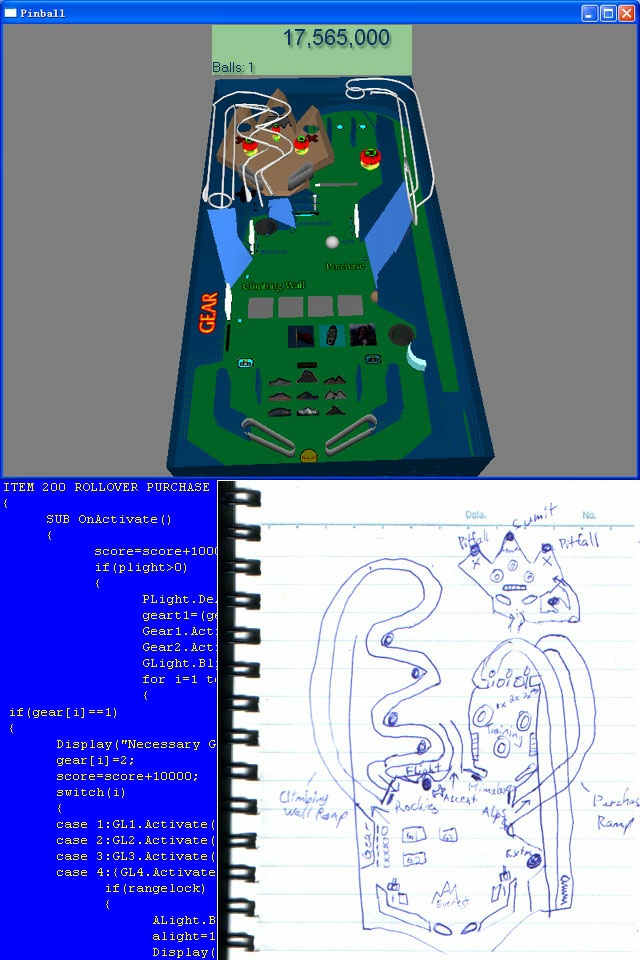 |

Submitted by , posted on 13 October 2003
|
 |

Image Description, by

This is the project I've been working on for the last two months, a 3D
shareware pinball game, probably going to be named 3D Pinball Arcade. The idea
was to make a pinball game in the tradition of real-world pinball machines that
was in full, real-time 3D (something that doesn't seem to exist already
anywhere I've looked) where it would be easy to design and build tables quickly.
This way I could afford to build a large number of tables in addition to the free
one, providing a large incentive for players to register.
One thing that should be obvious is my desperate need of a decent artist
for drawing table and back-glass surfaces. What you are looking at is my
Programmer Art, which I'm not proud of. Any good 2D artist with an intuitive sense
of graphic design would be most welcome to join me on this project for royalty
payments. Anyone interested can email me at Tubular42@AOL.COM with some
samples of their work. I would prefer hand-drawn art, but most important is a good
sense of layout and aesthetics.
The game is about 60% done, including physics, sound, animations, a script
parser for programming the table's rules, and most of the 3D graphics basics.
The shot at the top of the picture shows my first table at its current state
of development. The table is named Everest, with a mountain climbing theme.
The shape of the base of the table is built out of transparent textures
generated from the collision data, which is just a bitmap itself showing solid areas
and table items. On top of that, the ramps and the mountain platform are a
single 3D Studio model, and the bumpers, lights, and targets are separate models
and textures referenced by the table's layout file. This cuts down 3D modeling
tasks to just the problem of trying to build the ramp rails without letting
the polygon count get out of hand. Still to come are a decent 3D backdrop to the
playing screen, and a 3D "arcade view" for choosing which table to play.
The bottom right part of the picture shows my original table design, which
I drew before actually beginning coding on the game itself. I think it turned
out fairly close to the original design, which makes me optimistic that it
will be powerful enough to build a wide variety of tables.
The bottom left part of the picture shows a small sample of the script
which controls the table's behavior. The script language is a simplified version
of C, with a few touches from Pascal only added to make the compiler easier to
write. I decided to write my own compiler and virtual machine to make sure
the language had all the features I needed, ran fast enough, and could be easily
integrated with my program. It uses a simple Context Free Grammar of only 110
terms, and an extremely simple first-fit method for parsing. This way I was
able to finish the whole compiler and VM in a little under two weeks using just
over 1000 lines of code, and including features like local functions, switch
statements, and a preprocessor that scans through the code looking for sound
and graphics calls, pre-caching the assets when needed, and replacing their
reference in the code with a handle to the unique copy in memory. The only
drawbacks to my simple compiler are that order of operations doesn't work on some
complex expressions, requiring what would otherwise be unnecessary parentheses,
and syntax error messages are extremely cryptic or misleading. However, due to
the relative simplicity of Pinball rules, I was willing to make these
sacrifices.
Once all of the kinks are worked out, designing additional tables should
be a breeze, and anyone with medium skill in programming and a decent knowledge
of pinball should be able to pull it off. I should stress that this is not
going to be a table-building toolkit, as the tools I've been using aren't
exactly user friendly. It's merely a way of making my work easier in building many
tables. However anyone interested with good skill may contact me if they're
interested in helping me design a table for a small cut of the profit.
Thanks to anyone who read this whole thing for their interest and keep
an eye out for an IOTD or release of the finished version when I'm done!
Hopefully in mid October.
JT Hooker
|
|

